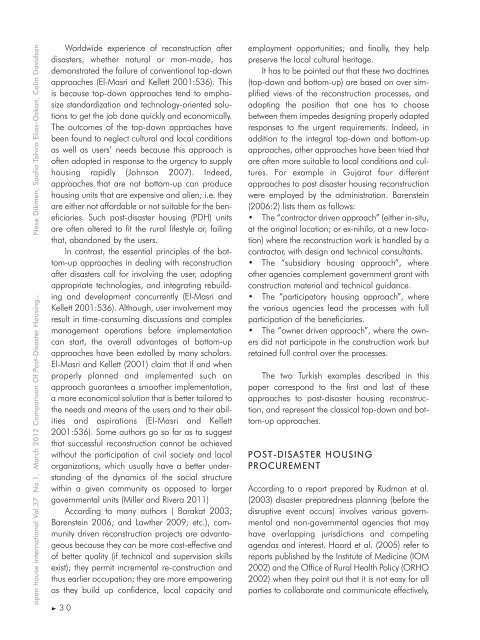Vol :37 Issue No.1 2012 - Open House International
Vol :37 Issue No.1 2012 - Open House International
Vol :37 Issue No.1 2012 - Open House International
You also want an ePaper? Increase the reach of your titles
YUMPU automatically turns print PDFs into web optimized ePapers that Google loves.
Nese Dikmen, Soofia Tahira Elias-Ozkan, Colin Davidson<br />
open house international <strong>Vol</strong>.<strong>37</strong> <strong>No.1</strong>, March <strong>2012</strong> Comparison Of Post-Disaster Housing...<br />
Worldwide experience of reconstruction after<br />
disasters, whether natural or man-made, has<br />
demonstrated the failure of conventional top-down<br />
approaches (El-Masri and Kellett 2001:536). This<br />
is because top-down approaches tend to emphasize<br />
standardization and technology-oriented solutions<br />
to get the job done quickly and economically.<br />
The outcomes of the top-down approaches have<br />
been found to neglect cultural and local conditions<br />
as well as users’ needs because this approach is<br />
often adopted in response to the urgency to supply<br />
housing rapidly (Johnson 2007). Indeed,<br />
approaches that are not bottom-up can produce<br />
housing units that are expensive and alien; i.e. they<br />
are either not affordable or not suitable for the beneficiaries.<br />
Such post-disaster housing (PDH) units<br />
are often altered to fit the rural lifestyle or, failing<br />
that, abandoned by the users.<br />
In contrast, the essential principles of the bottom-up<br />
approaches in dealing with reconstruction<br />
after disasters call for involving the user, adopting<br />
appropriate technologies, and integrating rebuilding<br />
and development concurrently (El-Masri and<br />
Kellett 2001:536). Although, user involvement may<br />
result in time-consuming discussions and complex<br />
management operations before implementation<br />
can start, the overall advantages of bottom-up<br />
approaches have been extolled by many scholars.<br />
El-Masri and Kellett (2001) claim that if and when<br />
properly planned and implemented such an<br />
approach guarantees a smoother implementation,<br />
a more economical solution that is better tailored to<br />
the needs and means of the users and to their abilities<br />
and aspirations (El-Masri and Kellett<br />
2001:536). Some authors go so far as to suggest<br />
that successful reconstruction cannot be achieved<br />
without the participation of civil society and local<br />
organizations, which usually have a better understanding<br />
of the dynamics of the social structure<br />
within a given community as opposed to larger<br />
governmental units (Miller and Rivera 2011)<br />
According to many authors ( Barakat 2003;<br />
Barenstein 2006; and Lawther 2009; etc.), community<br />
driven reconstruction projects are advantageous<br />
because they can be more cost-effective and<br />
of better quality (if technical and supervision skills<br />
exist); they permit incremental re-construction and<br />
thus earlier occupation; they are more empowering<br />
as they build up confidence, local capacity and<br />
3 0<br />
employment opportunities; and finally, they help<br />
preserve the local cultural heritage.<br />
It has to be pointed out that these two doctrines<br />
(top-down and bottom-up) are based on over simplified<br />
views of the reconstruction processes, and<br />
adopting the position that one has to choose<br />
between them impedes designing properly adapted<br />
responses to the urgent requirements. Indeed, in<br />
addition to the integral top-down and bottom-up<br />
approaches, other approaches have been tried that<br />
are often more suitable to local conditions and cultures.<br />
For example in Gujarat four different<br />
approaches to post disaster housing reconstruction<br />
were employed by the administration. Barenstein<br />
(2006:2) lists them as follows:<br />
• The “contractor driven approach” (either in-situ,<br />
at the original location; or ex-nihilo, at a new location)<br />
where the reconstruction work is handled by a<br />
contractor, with design and technical consultants.<br />
• The “subsidiary housing approach”, where<br />
other agencies complement government grant with<br />
construction material and technical guidance.<br />
• The “participatory housing approach”, where<br />
the various agencies lead the processes with full<br />
participation of the beneficiaries.<br />
• The “owner driven approach”, where the owners<br />
did not participate in the construction work but<br />
retained full control over the processes.<br />
The two Turkish examples described in this<br />
paper correspond to the first and last of these<br />
approaches to post-disaster housing reconstruction,<br />
and represent the classical top-down and bottom-up<br />
approaches.<br />
POST-DISASTER HOU SING<br />
PR OC UR EMENT<br />
According to a report prepared by Rudman et al.<br />
(2003) disaster preparedness planning (before the<br />
disruptive event occurs) involves various governmental<br />
and non-governmental agencies that may<br />
have overlapping jurisdictions and competing<br />
agendas and interest. Hoard et al. (2005) refer to<br />
reports published by the Institute of Medicine (IOM<br />
2002) and the Office of Rural Health Policy (ORHO<br />
2002) when they point out that it is not easy for all<br />
parties to collaborate and communicate effectively,





